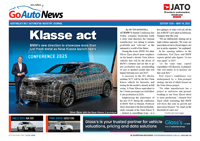Future models - Toyota - X-RunnerFirst look: X-Runner is a first for ToyotaAussie package: A utility body was judged to be the best way to showcase Australian design. Meet the first locally designed and built Toyota concept car3 Mar 2003 By BRUCE NEWTON IT may not look ground-breaking, but Toyota Australia's X-Runner concept revealed on Friday at the Melbourne motor show is potentially the start of a new era for the company. The first concept designed and built in-house by the Japanese giant's Australian arm is intended to flag local ability to headquarters as much as impress Melbourne show goers. Toyota Australia wants to take more control of its styling and design direction, just as it has gained increasing levels of engineering control in recent years. To that end, Toyota Australia has been developing its design ability quietly since mid-2002, employing more staff at its Port Melbourne technical centre including Nissan chief stylist Paul Beranger. Mr Beranger supervised work on the X-Runner that began nine months ago. The choice of vehicle style - a monocoque utility - is significant because of its popularity in Australia. "We can make a four-door sedan concept car or convertible or a coupe, but this concept is really exclusive to Australia," said Toyota Australia associate director and divisional general manager product engineering Max Gillard. "We wanted something that would identify with the local market." "It's very big step. From where we have been seen as just adopting TMC or Japanese design, X-Runner has really proven to ourselves and TMC - and hopefully you guys - that we are capable of matching it with anyone else." The styling of the X-Runner is intentionally linked to the current Avalon with the front cabin, bonnet and headlights all employed, although the grille is new. Other styling features include a swing-out tailgate incorporating a removable backpack for storage. But there's also room in the tray for two storage lockers, a refrigerator, mountain bike attachment rails and a global positioning system and plasma screen - for tracking the mountain bikes fitted in the back of X-Runner. Interior appointments include sports bucket seats, touch-screen satellite navigation and six-speaker audio. Toyota Australia's ambition is to have a design department capable of doing a vehicle from the ground-up. If Toyota Motor Corporation is impressed by X-Runner, that could be a key in gaining that ability. The replacement for the current Avalon, due in 2005, is a car the company has ambitions to do locally. Little by little design control is already edging Toyota Australia's way. The facelifted Avalon due later this year has been completed out of the Melbourne office of German design company Edag, under Toyota Australia direction. The facelifted locally-built Camry due in 2004 takes another step, being designed in-house at the company's Port Melbourne headquarters. However, styling capability alone is not the only significance of X-Runner. There's also a foretaste of coming technology under the body. It is built on the local Toyota Modular Platform (TMP) - which underpins the current Camry and Avalon - which has been stretched 150mm. A supercharged version of the 3.0-litre V6 1MZ-FE engine used in Camry and Avalon sits under the bonnet, while drive is distributed to all four wheels via a modified version of the Lexus RX300 viscous-coupled all-wheel drive system. Each of these items is significant. The engine - which uses a supercharger developed by TRD - is being considered for use in the Sportivo Camry, the adaptation of the all-wheel drive system helps the case for the build of a soft-roader as a third model line at the Altona plant in Melbourne, while the stretched wheelbase is being considered for the next Avalon to differentiate it further from the Camry. The X-Runner's extra wheelbase is gained by adding 150mm to the TMP at the front of the rear wheel arch. Other technical features of X-Runner include a torsion beam rear suspension adapted from the Toyota Tarago 4WD while MacPherson struts are retained up-front, a high performance PBR brake package and 19-inch alloy wheels mated to 245/45 Dunlop tyres laser cut with the Toyota logo. The combination of these technologies into a running vehicle also serves to back up Toyota Australia's bid for a large chunk of a new Asia-Pacific research and design facility that Toyota in Thailand is also bidding for. Toyota Australia will get a share of the facility, but now the fight is on to decide which areas of responsibility will be allocated here and which go to Thailand. While TMC had to approve the display of the X-Runner, company heavyweights including the vice-president of engineering will site the vehicle for the first time this week when they visit Australia for the Formula One grand prix. Toyota X-Runner Specifications Engine: Quad Cam 3.0-litre all-alloy V6, with VVT-i and supercharger Transmission: Four-speed electronically controlled automatic Driveline: Four-wheel drive with viscous-coupled centre differential Steering: Power-assisted rack and pinion with variable gear ratio system Front brakes: 355mm diameter ventilated discs with twin-piston callipers Rear brakes: 343mm diameter ventilated discs with single-piston callipers ABS: Four-channel, four-sensor Front suspension: Independent struts with coil springs, hydraulic dampers and ball-joint linked stabiliser bar Rear suspension: Torsion beam axle with coil springs, hydraulic dampers and internal stabiliser bar Wheels: 19 x 8 aluminium alloy Tyres: Dunlop 245/45 R19 Overall length: 4905mm Overall width: 1910mm Overall height: 1520mm Wheelbase: 2870mm Front track: 1610mm Rear track: 1660mm Kerb weight: 1710Kg Seating capacity: 2 |
Click to shareToyota modelsResearch Toyota Motor industry news |














Facebook Twitter Instagram